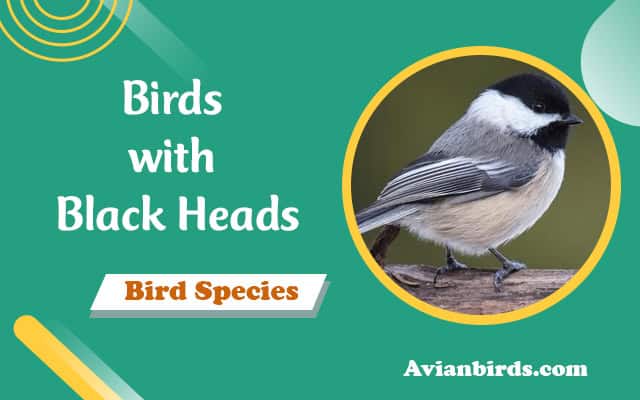Birds with Black Heads (Top 8 Species With Pictures)
Ever wonder why birds with black heads are so fascinating? They are not just pretty to look at. They also have unique sounds and ways of acting. Let’s explore the world of birds with blackheads together.
We’ll learn about their homes, what makes them special, and more. You’ll see pictures of birds like the Black-headed Grosbeak and the Black Skimmer. These birds are amazing and play important roles in our world.
What are Black-Headed Bird Species?
Black-headed bird species are fascinating birds with dark heads. They belong to different families and live in various places. The Red-Winged Blackbird and the American Crow are well-known examples.
These birds play important roles in our ecosystems. They add beauty and help keep nature balanced.
The Black-headed Grosbeak is another interesting bird. It’s about 8½ inches long and has a bold look. Males have black heads and orange chests.
Black-headed Grosbeaks eat insects and fruits. They eat about 60% animal food. This helps control insects and spreads seeds.
Learning about black-headed bird species helps us appreciate them more. We can celebrate their roles in nature and work to protect them.
Identifying Birds with Black Heads
Looking for birds with black heads can be fun and rewarding. We need to look at size, color, and how they act. These details help us spot the many black-headed birds in the sky.
Size and Shape
The size and shape of a bird are key clues. For example, Black-capped Chickadees are smaller than sparrows. This helps us tell them apart from other birds.
American Crows are bigger than Common Grackles. This makes it easier to tell them apart when we’re birdwatching.
Color Patterns
Color patterns are important for identifying birds with black heads. The Black-capped Chickadee has a black cap and white cheeks. It also has a soft gray back and buffy underparts.
Common Grackles have a blue-purple head and yellow eyes. American Crows and Common Ravens are all black. Changes in seasons or sex can make some birds harder to identify.
Behavioral Characteristics
How birds act can also help us identify them. Black-capped Chickadees are great flyers and often fly in groups. This shows they like to be together.
Some birds, like American Crows, like to be in groups too. But Common Ravens are usually alone. Listening to their calls can also help us tell them apart. The American Crow’s call is scratchy, while the Common Raven’s is deeper.
| Bird Species | Size | Color Pattern | Behavior |
|---|---|---|---|
| Black-capped Chickadee | Smaller than sparrows | Black cap, white cheeks, gray back | Social, acrobatic, flies in flocks |
| American Crow | Larger than grackles | Completely black | Social, forms flocks |
| Common Raven | Similar to crows | Completely black | Often solitary or in pairs |
| Common Grackle | Similar in size to Blue Jays | Blue-purple head, yellow eyes | Commonly found in urban areas |
| European Starling | Similar to grackles | Black with white spots | Often found in flocks |
Top 8 Birds with Black Heads
Exploring birds with black heads shows us amazing diversity and unique traits. These birds stand out with their striking looks and behaviors. We’ll look at eight birds, each with interesting facts that help us understand them better.
Adult male birds often have a bold black head and colorful bodies. Females and young birds have warm colors like orange, buff, or brown. These colors help us identify them in nature.
- Yellow-Headed Blackbird: Common in central Oregon, known for its black and yellow.
- Western Meadowlark: Seen at Pointe Mouillee state game area in Michigan, loved for its song.
- Scott’s Oriole: Found in Los Cabos, Mexico, and southwestern U.S., with stunning black and yellow.
- Common Yellowthroat: Often seen in Bucks County, Pennsylvania, known for its mask.
- Evening Grosbeak: Seen in winter, attracting birdwatchers with its visit.
- Hooded Warbler: Noted during spring migration near Charleston, West Virginia, admired for its colors.
- Western Tanager: Known for its feeding behavior, attracted to oranges in gardens.
- American Goldfinch: A favorite, loved for its bright yellow and energetic movements.
These birds have different ways of eating, like visiting backyard feeders for sunflower seeds. They can be found in places like California, Arizona, Montana, and Washington. Their varied looks and habits add to our wildlife observations, showing the richness of nature.
| Bird Species | Coloration (Adult Males) | Common Locations | Feeding Behavior |
|---|---|---|---|
| Yellow-Headed Blackbird | Black head with yellow body | Central Oregon | Insects and seeds |
| Western Meadowlark | Black and yellow | Pointe Mouillee, MI | Insects and seeds |
| Scott’s Oriole | Black and golden yellow | Los Cabos, Mexico | Fruits and nectar |
| Common Yellowthroat | Olive green with black mask | Bucks County, PA | Insects |
| Evening Grosbeak | Bright yellow with black head | Various, winter migration | Sedges and seeds |
| Hooded Warbler | Bright yellow with black hood | Charleston, WV | Insects |
| Western Tanager | Red head with yellow-orange body | Gardens across the U.S. | Fruits and insects |
| American Goldfinch | Bright yellow with black wings | Across the U.S. | Seeds from plants |
Each bird with a black head adds something special to the bird world. Their colors and eating habits make birdwatching more exciting and rewarding.
1. Red-Winged Blackbird
The red-winged blackbird is a well-known bird in North America. Knowing where they live and how to spot them makes them even more interesting.
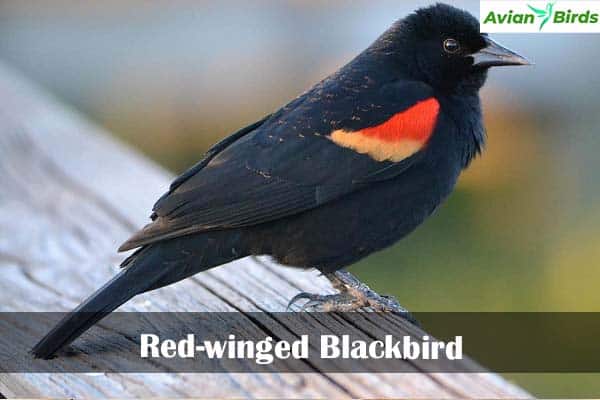
Habitat and Distribution
Red-winged blackbirds live in many places, like wetlands and grasslands. They are common in winter, often in huge groups. These groups can have thousands of birds.
They like to be with other birds in winter. This shows how they behave in groups.
Identification Features
The male red-winged blackbird is easy to spot because of his bright red shoulder patches. He is black and about the size of a robin. The female is brown and less noticeable.
Looking at their colors helps us understand where they live and how they adapt.
| Feature | Male Red-Winged Blackbird | Female Red-Winged Blackbird |
|---|---|---|
| Coloration | Black body with red shoulder patches | Streaked brown plumage |
| Size | Robin-sized, smaller than a common grackle | Similar in size, often less robust |
| Behavior | Sociable, territorial during breeding | Often nest in wetland areas |
2. Yellow-Headed Blackbird
The yellow-headed blackbird is a bright bird with yellow and black feathers. It lives in wetlands in the western United States. Watching it helps us understand its place in nature.
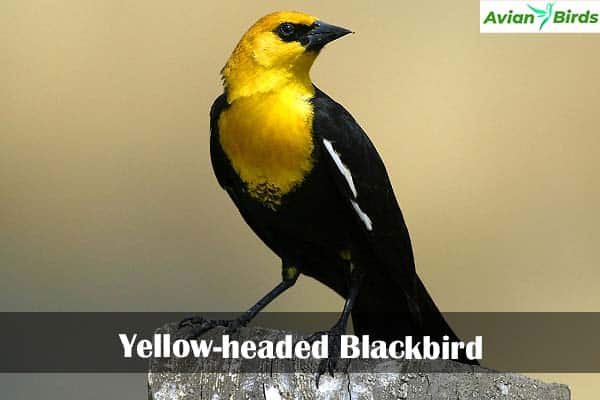
Habitat Preferences
These birds like freshwater marshes, especially with cattails and reeds. They nest with red-winged blackbirds. One male can have up to eight mates.
They breed in eastern Washington from April to September. In winter, they travel to the southwestern United States and Mexico in large groups with other birds.
Unique Traits
The yellow-headed blackbird has a special way of singing. Their songs are called “accent songs” and “buzz songs.” These sounds are different from other blackbirds.
The males have bright yellow heads and breasts, while the females are brown with a yellow throat. Young birds are brown but become more yellow as they grow up.
| Characteristic | Details |
|---|---|
| Scientific Name | Xanthocephalus xanthocephalus |
| Length | 8.3–10.2 in (21–26 cm) |
| Wingspan | 16.5–17.3 in (42–44 cm) |
| Weight | 1.6–3.5 oz (44–100 g) |
| Diet | Primarily seeds and insects |
| Nesting | Built in marsh vegetation over open water |
| Incubation Period | 12 to 13 days |
| Fledging Period | 9 to 12 days post-hatching |
3. Rusty Blackbird
The rusty blackbird is known for its unique look and behavior. Males change color with the seasons. In summer, they are dark glossy black. In fall, they have rusty edges.

Females are gray-brown, adding to their beauty in wetlands.
Seasonal Plumage Changes
The rusty blackbird’s feathers change from summer to winter. Males turn glossy black, losing their rusty edges. Females keep some rusty tones until spring.
Their pale yellow eyes stand out against their dark bodies. This makes them easy to spot among black-headed birds.
Feeding Habits
Rusty blackbirds live in wetlands like marshes and ponds. They hunt for insects and seeds, especially in winter. During migration, they join small flocks of blackbirds.
This shows how they eat and why wetlands are crucial for them. Knowing this helps us protect their homes.
| Feature | Male Rusty Blackbird | Female Rusty Blackbird |
|---|---|---|
| Coloration in Breeding Season | Glossy black with greenish sheen | Gray-brown with rusty edges |
| Eye Color | Pale yellow | Pale yellow |
| Size | Medium-sized | Medium-sized |
| Preferred Habitat | Wet areas, bogs, boreal forests | Wet areas, boreal forests |
| Diet | Insects and seeds | Insects and seeds |
4. Brewer’s Blackbird
The Brewer’s Blackbird is a medium-sized bird that catches the eye. Males have shiny black feathers, while females are brown. They live in open places like coastal scrub, grasslands, and city streets in the western U.S.
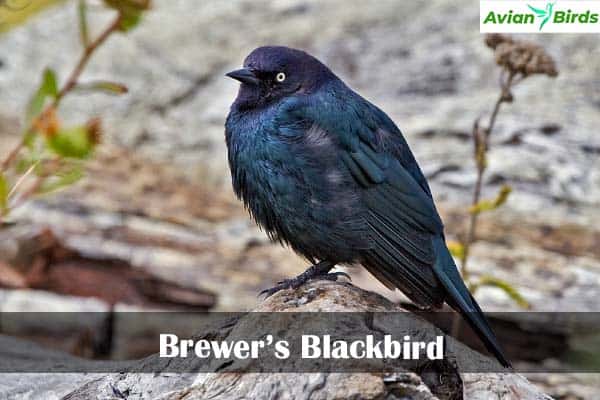
Typical Locations
Brewer’s Blackbirds can be found in:
- Coastal scrub
- Grasslands
- Fields and meadows
- Lawns and parks
- Golf courses
- City streets
Identification Tips
Identifying Brewer’s Blackbirds is fun. They are about the size of a Red-winged Blackbird. Males have glossy black bodies with a purple or blue sheen on their heads. This sheen changes to greenish.
Females are darker on their wings and tail. They might show a greenish sheen on their backs. They walk and feed in a unique way, adding to their charm. Watching their slow flight in flocks helps identify them.
| Measurement | Size in Inches | Size in mm |
|---|---|---|
| Length | 8 to 10.3 in | 200 to 260 mm |
| Weight | 2.2 oz | 63 g |
| Wingspan | 15.5 in | 390 mm |
| Wing Length | 4.8 to 5.2 in | 121 to 133 mm |
| Tail Length | 3.74 to 4.04 in | 95 to 102.5 mm |
These details help us identify Brewer’s Blackbirds better. They make birdwatching more fun.
5. Tricolored Blackbird
The tricolored blackbird is found mainly in California. It has striking colors and interesting social behavior. Knowing about this bird is key, especially since its numbers have been falling.

Societal Behavior
The tricolored blackbird shows unique behavior, especially when breeding. They form huge colonies, sometimes with hundreds of thousands of birds. In the 1930s, one colony was nearly 59 acres big.
Their numbers have dropped dramatically due to lost habitats and farming. Today, only about 300,000 birds remain from 2-3 million.
Parent birds teach their young to fly by flying back and forth with food. This helps the young learn to find their way, and these social actions are key to their survival.
Habitat in California
The tricolored blackbird lives in California’s wetlands. It loves areas with lots of plants, which give it food and help it raise its young.
Some birds are now seen outside California, like in Washington State. They can fly up to 3 miles to find food. This shows they are looking for better places to eat.
It’s important to keep their habitats safe. Wetlands are disappearing, which hurts their numbers. We need to protect and restore these areas.
6. Common Grackle
The common grackle is known for its dark and shiny feathers. In the right light, males have blue heads and bronze bodies, while females have less shiny feathers. These birds make unique sounds like squeaks and whistles.
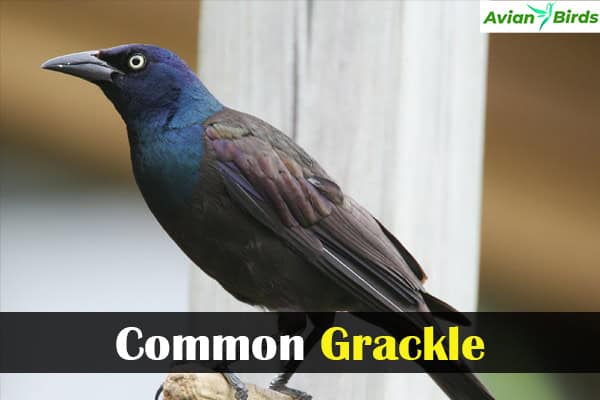
Common grackles live in many places like fields, parks, and lawns. They are good at living near people. Adult males are bigger than some birds but smaller than others. They look for food on the ground and in fields.
Young grackles look brown with dark eyes. They eat seeds, bugs, and small animals. They are found all over the United States all year, though some move a little in winter.
Some farmers see grackles as pests, but others see them as helpful. Female grackles build nests in trees, sometimes near water, which makes their breeding interesting.
| Characteristic | Males | Females | Juveniles |
|---|---|---|---|
| Plumage | Iridescent bluish heads, bronzy bodies | Duller than males | Brownish overall |
| Size | Larger than Red-winged Blackbird | Smaller than males | Similar to adults but with less color |
| Diet | Grains, insects, fruit | Grains, seeds, and insects | Similar to adults |
| Habitat | Agricultural fields, parks | Nests in conifers | Found among adult populations |
7. American Crow
The American Crow is a smart black bird. It can live in many places. Its all-black feathers make it easy to spot.
This crow is big, almost as big as a Blue Jay. It’s smaller than a Common Raven. It looks strong in the sky.
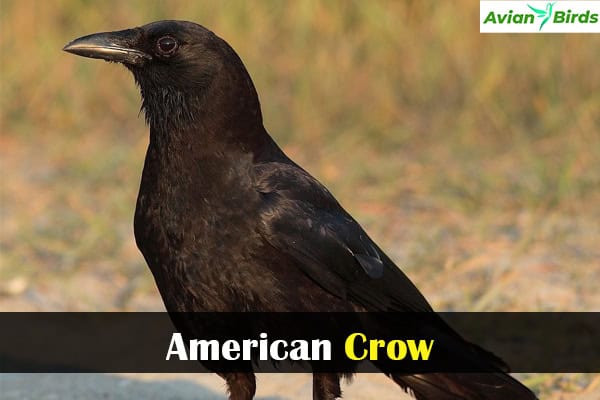
In different places, crows can be a bit different. Crows in the West are smaller than those in the East. In Florida, crows have big feet. Until 2021, crows in the Pacific Northwest were their own species.
Crows like to be together. They can form huge groups. Watching them shows how smart they are.
They eat almost everything, including small animals, seeds, fruits, and even trash. They are very good at finding food.
Crows live in many places. We see them in fields, forests, and cities. It’s important to know the difference between American Crows and Fish Crows in Massachusetts.
| Characteristic | American Crow | Blue Jay | Common Raven |
|---|---|---|---|
| Size | Large, nearly chicken-sized | Medium | Largest among crows |
| Plumage | All black | Blue with white markings | Black with wedge-shaped tail |
| Call | Clear caw | Jarring jay sound | Deep croak |
| Diet | Omnivorous | Omnivorous | Varied, including carrion |
| Behavior | Highly social in flocks | Sometimes solitary | More solitary or pairs |
The American Crow is interesting to watch. They are smart and live in many places, showing us how clever black birds can be.
8. Common Raven
The common raven is a standout among black-headed birds. It’s big and has unique features. It’s much heavier than the American Crow, weighing 689 to 1,625 grams. The crow weighs less, at 316 to 620 grams.
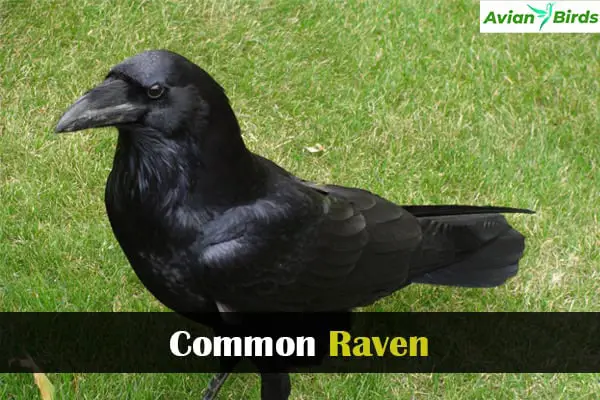
Ravens have a wingspan of 120 to 150 cm, which makes them look even bigger. Their tail and neck shape make them easy to spot in the sky. Watching them fly is amazing, as they show off their smarts and problem-solving skills.
Common ravens are often alone or in pairs. This is different from crows, which are in big groups. Their loud calls can be heard everywhere, from mountains to cities.
In short, the common raven is fascinating. It’s big, smart, and interesting to watch. They live in many places, showing us the beauty of birds in our world.
Conclusion
Birds with black heads are fascinating. They make our world more interesting and fun for birdwatchers in the United States. Birds like the American Crow and the Tricolored Blackbird are unique and charming.
Learning about these birds improves birdwatching and helps us appreciate the places they live. Knowing about their looks, homes, and ways also helps us enjoy wildlife more.
Let’s keep exploring and learning about black-headed birds. We must also protect their homes. This way, future bird lovers can see their beauty too.
Read More 🐦Related Articles:
| Small Birds With Yellow Chests |
| Owls In The Family |
| Can Turkeys Fly |
| Can Flamingos Actually Fly |
| Can Peacocks Fly |
Frequently Asked Questions
Q1. What types of birds have black heads?
Many birds have black heads, including chickadees, black-capped warblers, and certain finches and sparrows.
Q2. How can you identify birds with black heads?
Look for distinguishing features like size, body color, beak shape, and unique markings on wings or tail to identify them accurately.
Q3. What are common small birds with black heads?
Common small birds with black heads include chickadees, blackpoll warblers, and some types of sparrows.
Q4. Which birds in North America have black heads?
North American birds with black heads include the black-capped chickadee, dark-eyed junco, and hooded warbler.
Q5. What does it mean when a bird has a black head?
A black head may serve as camouflage, a signal of maturity, or an identifier for attracting mates.
Q6. Are there finches with black heads?
Yes, such as the black-headed grosbeak and the lesser goldfinch.
Q7. What sparrows have black heads?
The Harris’s sparrow and black-throated sparrow are examples of sparrows with black heads.
Q8. How to attract black-headed birds to your backyard?
Offer bird feeders with seeds, suet, or nectar, provide water sources, and plant native shrubs or trees.
Q9. What’s the habitat of black-headed birds?
Black-headed birds inhabit various environments, from forests and woodlands to gardens and wetlands.
Q10. Why do some birds have black heads?
A black head can aid in camouflage, help with heat absorption, or play a role in social signaling and mate attraction.

